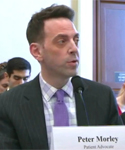ACR CONVERGENCE 2020—From understanding terminology, to collecting relevant data, to shaping a culture of awareness and inclusivity, clinicians can take many steps to improve the healthcare experience for LGBTQ+ patients, experts said at the ACR Convergence session, Enhance Care for LGTBQ+ Patients.
“All patients have the right to respectful and sensitive nondiscriminatory and effective medical care,” said Jillian Rose, PhD, MPH, LCSW, assistant vice president of community engagement, diversity and research at the Hospital for Special Surgery, New York City. “Transgender patients, especially, may face unique challenges in interactions with physicians and other healthcare professionals. Research shows that increasing healthcare provider education can have positive health outcomes for the LGBTQ+ community.”
LGBTQ+ patients have higher rates of depression, suicide, cancer, cardiovascular disease and many other conditions—largely due to a lack of screening and access to healthcare. But, if clinicians can be more intentional about being inclusive and approach care with openness, this can foster a sense of comfort and patient engagement that can lead to better outcomes, Dr. Rose said.
“To care for someone, we have to know who they are, and to really know how they identify,” she said.
Dr. Rose acknowledged that terms can change frequently, but that clinicians don’t have to be perfect in using them to engage more effectively. LGBTQIA+ is a newer umbrella term that includes those who identify as intersex and asexual. Intersex is a general term that captures a variety of conditions in which someone is born with a reproductive or sexual anatomy that doesn’t seem to fit within typical definitions of male and female. Asexual is meant to describe a person who experiences little or no sexual attraction to others. Asexual people may still engage in sexual activity.
Gender identity is a person’s inner sense of who they are, and sexual identity is how people identify their physical and emotional attraction to others.
“It’s important for us not to make assumptions,” Dr. Rose said. “Sometimes, you think someone is one gender identity so they must be attracted to the opposite sex—and that’s a gross mistake.
Crucial in the physician-patient interaction is asking patients who they are, how they identify and the pronouns with which they’d like to be referred.
“People who disclose gender identity and sexual orientation feel safer in discussing high-risk behaviors,” and are more likely to receive relevant screenings and have better engagement with the health system, Dr. Rose said.
‘Research shows that increasing healthcare provider education can have positive health outcomes for the LGBTQ+ community.’ —Jillian Rose, PhD, MPH, LCSW
A Hospital Initiative
Melissa Flores, MPH, LCSW, outcomes manager at the Hospital for Special Surgery, described her center’s hospitalwide intervention for promoting inclusive and safe care for LGTBQ+ patients. The initiative involved staff training on providing care to transgender and gender-non-conforming patients, federal and state laws, the hospital’s mission, a review of terms, and hospital’s script for data collection, and other tools and resources.
The hospital offers patients several opportunities to share their sexual orientation and gender identity (SOGI) data before their appointments, either with a patient portal or kiosks in waiting areas.
These data have been integrated into the electronic medical record, which can have important implications for care, Ms. Flores said. She mentioned a transgender patient whose demographic information was entered, but not their gender identity and sex at birth, leading to incorrect automatic lab calculations, which were based on legal sex. In another example, a nurse noticed the lack of an option to indicate the reason a patient didn’t have a period was due to hormone therapy. This option has since been added so relevant information can be included.
The goal is that the LGBTQ+ community “fully becomes integrated into the lifeblood of our hospital,” Ms. Flores said.
“Critical to this process has been our organization’s commitment to a culture shift that values diversity and inclusion for all,” she said.
Patient Perspective
Peter Morley, a prominent patient advocate with lupus and other health challenges who identifies as gay, said that when he was younger “discussing sexual identity and sexuality—that was not something I was comfortable with because I felt that I would be judged.”
When undergoing treatment for kidney cancer, his healthcare providers did not communicate with his same-sex partner.
“Having my caregiver not being involved is stressful,” Mr. Morley said. “Inclusion of my caregiver, whether it’s my same-sex partner, a friend, a family member, will definitely lead to better outcomes because they will be more prepared to help me manage my care.”
He has seen progress, but has testified several times on Capitol Hill to push for more change and inclusivity. The involvement of same-sex caregivers, in particular, is an area for improvement in healthcare, he said.
“There should be mandatory training for clinicians and their staff to teach them how to address caregivers because, to me, the more you incorporate the caregiver into the conversation—regardless of the nature of the relationship—the better patients will feel cared for, seen, and like many heterosexual partners, same-sex caregivers can provide invaluable support that can be a key factor in optimal patient care,” Mr. Morley said. “To truly make a difference in care outcomes and overall patient experiences, we need to begin these conversations.”
Thomas Collins is a freelance medical writer based in Florida.






